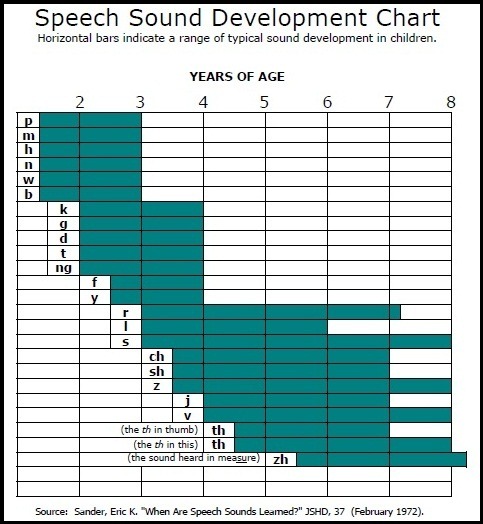Speech & Phonological Sound Acquisition
Speech Sound Development (Sander’s 1972)

Phonological Patterns
Denasalization – changing a nasal consonant to a non-nasal
- Example – “Mat” —> “Bat”
- Typically disappears when a child reaches 2:6
Assimilation – changing a phoneme so it takes on a characteristic of another sound in the word
- Example – “Cat” –> “Tat”
- Typically disappears at the age of 3:0
Affrication – when a child substitutes an affricate sound (“J” Judge or “Ch” Cheese) for a non-affricate sound (“S” or “Z”)
- Example – “Sheep” –> “Cheap”
- Typically disappears at the age of 3:0
Final Consonant Deletion – when a child omits a singleton consonant at the end of a word
- Example – “Cat” –> “Ca”
- Typically disappears at the age of 3:0
Fronting of initial velar singles – when a substituting a front sound for a back sound
- Example – “Can” –> “Ca”
- Typically disappears at the age of 4:0
Deaffrication – when a child replacing an affricate (i.e. “SH”) with a continuant (i.e. “S”) or stop (i.e. “P”)
- Example – “Chip” –> “Sip”
- Typically disappears at the age of 4:0
Cluster Reduction (without /s/) – omitting one or more consonants in a sequence of consonants
- Example – “grape” –> “gap”
- Typically disappears at the age of 4:0
Depalatalization of final singles – substituting a nonpalatal (i.e. “T”) for a palatal sound (i.e. “SH) at the end of a word.
- Example – “Dish” –> “Dit”
- Typically disappears at age of 4:0
Depalatalization of initial singles – substituting a nonpalatal (i.e. “Sh”) for a palatal sound at the beginning of word
- Example – “Shy” –> “Tai”
- Typically disappears at the age of 4:0
Alveolarization – when a child substitutes an alveolar (i.e. “T”) for a nonalveolar sound (i.e. “Ch”)
- Example – “Chew” –> “Tew”
- Typically disappears at the of 4:0